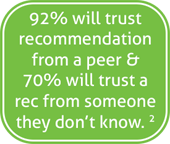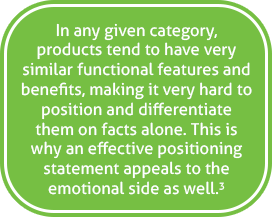This post is in addition to the 9 Drivers to RFP Response Success series. To start from the beginning, visit the first post.
An RFP response may not seem like it has much in common with your favorite book, but have you ever been disappointed when you see a movie adaptation after reading the novel? Do you ever think to yourself, “Gosh, it was just so much better on the page?”
That’s because well-written books invite you to imagine the story’s progression in a way that’s particular to yourself. Good writers are storytellers and understand how to show rather than tell, no matter what they’re writing—even when you’re thinking about how to respond to an RFP.
We “Tell” a lot in our RFP responses.

I was recently facilitating a training session on best practices for how to respond to an RFP with a large RFP response team. In preparation for the training, our team reviewed several of their recently submitted RFP response samples and proposals. Like many of the large organizations we work with, their responses were clear, consistent, and layered with lots and lots of detail. But as I was shaping the specific talking points and activities of the 4-hour training session for this team, I homed in on one specific area of focus: Show… don’t tell.
You may be thinking that the goal of an RFP response is to tell. On the surface, the RFP response process is about you sharing all the details about your solution, how it works, who is involved, what it does, and how much it costs. But if you are only telling, you are leaving it up to the evaluator to connect the dots on how that solution will fit into their world.
What Does it Mean to Show Versus Tell?
Tell: When you tell rather than show, your RFP response simply informs the evaluator/reader of information rather than allowing them to deduce anything. You’re supplying information by stating it. Example: My widget is small, brown, and square. That’s telling.
Show: Showing paints a picture that the evaluator can see come to life as it relates to their business or organization, their employees or their customers or members. Example: When installed, the 1” by 1” widget will take up minimum space, fit in with your office’s modern décor and match your current color pallet. That’s showing.
Showing versus telling in fact-based technical RFP responses is easier said than done, especially when you have limited space to provide a response. Here’s how to respond to an RFP while shifting your focus thoughtfully and consistently to show your story and stand out from competitors that are just telling theirs:
Leverage Client Testimonials: It’s often said that our clients sell us better than we do. Capitalize on your many successful client relationships and include testimonials that are aligned and relatable in your RFP response.
Share Success Stories: Present multiple anecdotes and past successes to bring your proposal to life. Rather than just spewing off facts, figures, or your years of experience, paint a dynamic picture of the path ahead so that clients can envision themselves taking the next step with you. It will help bring your solutions to life in the real world.
Show Your Learnings: Don’t be afraid to share examples of times you were faced with a negative situation and what you did to turn it around, accompanied with the results of the recovery. It will make your company feel more human and relatable and show that you know how to solve problems.

Demonstrate Innovation: Have you formed a team to work through a specific market problem or developed a new internal process to improve delivery of goods or services to your clients? Do you publish thought leadership? If you infuse any of those examples throughout your proposal or RFP, it can show your prospect that your organization is innovative, and you don’t shy away from difficult problems.
Prove it with Proof Points: If you make a claim, support it in your RFP responses with evidence. Proof points ensure your solution is accurate, convincing, and believable. Think of it as a “don’t just take our word for it” statement.

When it comes to how to respond to an RFP, simply stating the features of your product or service isn’t enough anymore. It puts too much of the burden on your buyer’s side of the RFP response process and likely puts you side-by-side with competitors. Instead, describe the ways your product or service ultimately fulfills a benefit, need, or solves their problem.
Chat with us to discuss how we can help your team infuse “showing” into your RFP proposal to help you put that product or service in the hands of your customer, so you can stand out from your competition.
1 www.forbes.com Six Tips to Telling a Better Business Story
2 https://contentmarketinginstitute.com/2017/06/strategies-customer-testimonials-content/
3 https://www.entrepreneur.com/article/237737 Find Your Brand’s Proof Points
About Weber Associates
Weber Associates is a Columbus, OH based consulting firm. Since 1985, we have blended the creativity of a marketing agency with the analytical rigor of a consultancy to help our clients significantly grow revenues and customer loyalty. People hire us to solve real sales and marketing challenges. To improve their sales process. To grab someone’s attention and selling something. In short, they hire us to make their marketing make more sales.


